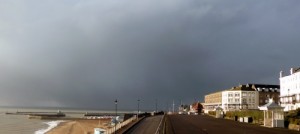
Winter of the Coast of Ramsgate
On a rainy day in the winter you might not think that there was much of archaeological significance to see on Thanet’s coast. However, the wind and high seas of January and February are causing one of the most important phenomena of the coast of the Isle of Thanet. the raging seas are driving thousands of flints up the beach, battering at the feet of the chalk cliffs.
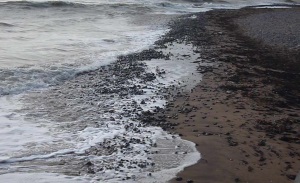
If you’ve ever wondered why cliff falls happen so often along Thanet’s coast in stormy weather, you don’t need to look any further than the relentless pounding these little grey hammers give to the chalk with each wave that rushes to the shore. Eventually the lower reaches of the cliff face are hollowed out by the rolling cobbles, the chalk above isn’t supported at the base any more and something has to give and down comes another stretch of the coast in a spectacular fall.
The process has a proper name – ‘Corrasion‘ and has been going on for a many centuries. John Lewis, the great 18th century historian of Thanet, wrote of ‘the rage of the sea and the falling of the land’ and recounts that in his time a Roman wall had fallen into the sea near the cliffs at Dumpton. Even now pits, ditches and graves of our ancient past are occasionally exposed at the cliff faces around the coastline, soon falling to the beach below.
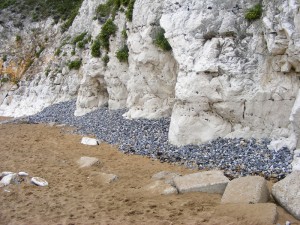
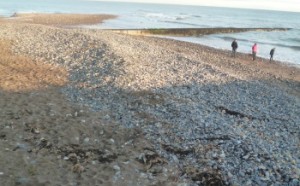
The waves and tides have another effect, collecting great banks and drifts of flint shingle in the shallows where the chalk has been cut to form a flat platform. One bank lies off the coast at Ramsgate, to the east of the harbour, growing and shrinking over time and occasionally, when the tide is unusually low, it is possible to walk far out along its length.
Some of the flints bound up in the depths of bank are irregular nodules of huge dimensions, pitted with undulating depressions and pierced with holes. Before the stone harbour was built Ramsgate’s haven was shielded by a similar deep bank of shingle braced with timber breakwaters. Some timber piles that were destroyed when the slipway in Ramsgate Harbour was built were thought by one observer, a former Harbour Master at Ramsgate, to have have dated to the Roman period. Perhaps the great Stonar Bank, which once stretched across Pegwell Bay and was once firm enough to support a medieval village, looked something like this .
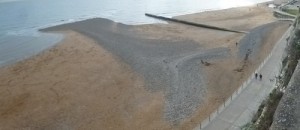
In Thanet the record of the power of the sea to shape our landscape is all around us and has been present since the earliest times in our history.